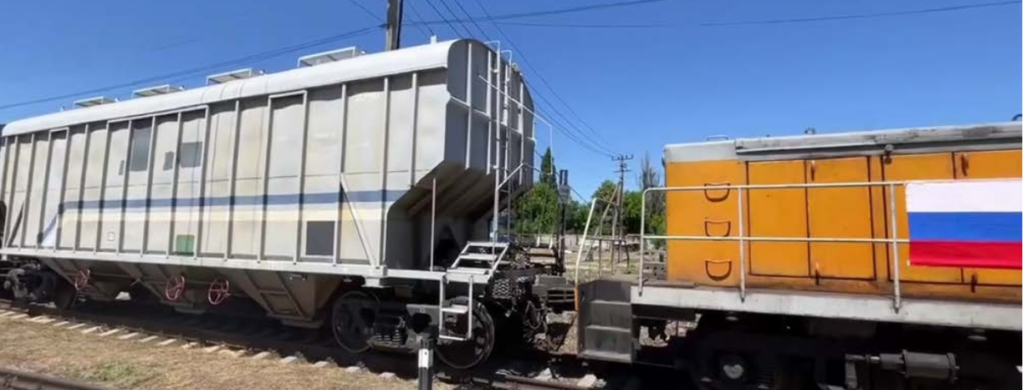Russia’s “unprecedented” Ukrainian grain theft premeditated war crime, legal report suggests
The grand pillaging was planned ahead of the invasion and is purposefully designed to starve populations in Global South, Global Rights Compliance says The post Russia’s “unprecedented” Ukrainian grain theft premeditated war crime, legal report suggests appeared first on Euromaidan Press.

Since Russia’s full-scale invasion of Ukraine in February 2022, Russia stole 6 million tons of Ukrainian grain, causing direct losses of nearly $9 billion to the Ukrainian agricultural sector and indirect losses of $31.5 billion. The extensive theft included the seizure of farms and larger agricultural entities, impacting a sector that constituted approximately 10% of Ukraine’s GDP, as per the World Bank’s 2021 estimate. Ukraine, previously a leading global exporter of wheat, barley, and corn, faced a significant disruption.

Deliberate and systematic grain theft by Russian forces has severely disrupted Ukrainian grain exports, contributing to soaring global commodity prices and a broader food crisis. The stolen grain is transported through occupied areas, including Crimea, and eventually into Russia.
In response, the US imposed sanctions on Russian corporations and individuals involved in the illicit seizure and transfer of Ukrainian grain.
However, this is not the whole story. Russia prepared for this massive theft by purchasing additional dry cargo ships with specific parameters even before the start of the full-scale invasion. This deliberate strategy, along with Russia’s exit from the Black Sea Grain Initiative and attacks on Ukrainian grain infrastructure, also endangers intended recipients in food-insecure regions like the Horn of Africa, the Sahel, Yemen, and Afghanistan, worsening their existing food crises.
This suggests that Russia may have committed multiple war crimes, according to lawyers from an international human rights law firm, Global Rights Compliance (GRC).
“The highly systematized weaponization of Ukraine’s grain is unprecedented in modern history and has involved extremely intricate pre-planning. It is purposefully designed to deny food to civilian populations in third-States,” commented Yousuf Syed Khan, Senior Lawyer at GRC.
Their new report, based on an investigation using OSINT methods, claims that Russia’s goals include funding its war effort by profiting from grain exports, potentially violating the prohibition of using starvation as a method of warfare. Organized theft involves controlling critical facilities and infrastructure, likely constituting the war crime of pillage. We summarized the GRC findings for you.
Critical sites and participants in extensive Ukrainian grain theft
In mid-March 2022, the initial incidents of grain theft were reported in regions under Russian occupation. Following territorial capture, Russian forces took control of grain facilities owned by Ukrainian corporations and private farmers, solidifying their authority through affiliated civilian administration.
After seizing these facilities, Russian forces efficiently controlled transportation networks, overseeing railways and ports. They established a systematic approach to appropriation, orchestrating widespread logistical operations in Ukraine’s grain-rich southern regions—Luhansk and Zaporizhzhia oblasts—where grain was transported to and from occupied Crimea.

Commercial entities linked to Russian occupying authorities, particularly State or Municipal Unitary Enterprises, have played a vital role in the theft and export of grain. These entities were established at seized grain logistics hubs in Luhansk and Zaporizhzhia oblasts.
In the occupied part of Zaporizhzhia Oblast, Russia’s State Grain Operator is seizing grain in Melitopol, Kamianka Dniprovska, and Berdiansk. Russian occupying authorities invested in transport networks, with widespread rail operations facilitating grain transfer to Crimea or the Russian city of Rostov-on-Don. Agro-Fregat, a Rostov-on-Don agro-transportation firm, likely plays a crucial role in rail grain movement.
Berdiansk Port, now a Russian State Unitary Enterprise named Berdiansk Port Operator, loads barges with grain for short-haul transportation, potentially to Rostov-on-Don or Kerch (Crimea). In Sevastopol (Crimea), Crane Marine Contractors (CMC), a subsidiary of sanctioned Russian state-owned United Shipbuilding Corp., operates, having purchased grain carrier ships just before Russia invaded Ukraine. These ships of the specific dimensions accommodated by Sevastopol’s naval grain terminal have been observed in the Turkish ports of Iskenderun, Derince, and Dörtyol.
The Black Sea Grain Initiative (BSGI), initiated in July 2022 to reintroduce global grain exports, shipped over 32 million metric tons of Ukrainian grain to food-insecure regions such as the Horn of Africa, the Sahel, Yemen, and Afghanistan. However, Russia unilaterally refused to extend the initiative on 17 July 2023.
After that, Russia targeted Ukrainian ports, including grain terminals in Odesa and further down the Black Sea coast in Chornomorsk. Two of the three ports included in the BSGI were struck, and some 300,000 tonnes of grain were destroyed.
“This is Russia’s attempt to deepen the food crisis in the countries which depend on Ukrainian products,” Ukrainian Deputy Prime Minister Oleksandr Kubrakov said.
Grain theft in Luhansk Oblast
In the occupied part of Luhansk Oblast, Russian forces seized grain elevators in Starobilsk, Svatove, Bilokurakyne, and Novoaidar. Starobilsk, with the largest elevator in the oblast owned by one of Ukraine’s largest agricultural holdings Nibulon, was occupied within the first two weeks of the February 2022 offensive. The facility was registered as Starobilsky Elevator, a Municipal Unitary Enterprise in the so-called Luhansk People’s Republic (LNR).
On 18 May 2022, local media reported a railway refurbishment near Starobilsky Elevator, overseen by Viktor Molotok from Russian agricultural firm Kalmichanka.

On 10 June, a video showed “LNR” leader Leonid Pasechnik watching a train departure from Starobilsky Elevator to Rostov-on-Don, carrying 650 tonnes of grain linked to the United Grain Company (OZK), partially owned by the Russian State.
OZK carriages were spotted in occupied regions beyond Luhansk Oblast, evident in a video from Kherson Oblast and satellite imagery in Crimea. The restored rail infrastructure in Starobilsk led to increased rail traffic. Russian open-source commercial records indicate the seizure and incorporation of three nearby facilities—Starobilsky Elevator in Svatove, Bilokurakyne, and Novoaidar. The elevators in Bilokurakine and Novoaidar were owned and operated by another Ukrainian agricultural giant Agrotron.

In Svatove, a departing train from another Nibulon elevator, overseen by occupation authority customs officials, was documented. Satellite imagery showed rail activity at the Bilokurakyne elevator in October 2022, and military vehicles were observed at the Novoaidar elevator in April 2022, coinciding with extensive Russian activity in the area from April to May 2022.
In August 2022, Oleksiy Vadaturskyi, the head of Nibulon, and his wife were killed when a Russian S-300 missile struck their house in Mykolaiv. At the funeral, Vadaturskyi’s son expressed his belief to reporters that the strike was intentional.
Grain theft in Zaporizhzhia Oblast
In the occupied part of Zaporizhzhia Oblast, multiple grain elevators, like Melitopol, Kamianka-Dniprovska, and Berdiansk, are now “branches” of the Russian State Grain Operator, taken over by Russians by 17 March 2022. The enterprise claims a daily export capacity of about 12,000 tonnes from the occupied territory, listing 16 addresses across occupied Ukraine.
In March 2023, the enterprise claimed engagement in meetings between Dmitry Patrushev, the Russian Minister for Agriculture, and representatives of the occupation authorities for Zaporizhzhia Oblast in Moscow, indicating further ties to the Russian State.
Since Russia partially occupied Zaporizhzhia Oblast, Melitopol has become a hub for trafficking grain. The Melitopol Grain Elevator, listed under the State Grain Operator since 15 May 2022, witnessed extensive seizing activities, with videos showing trucks marked with the Russian Armed Forces’ ‘Z’ symbol arriving and departing with grain.

On 15 July 2022, Russian-appointed Melitopol authorities announced grain transportation from the Melitopol grain elevator to occupied Berdiansk and Sevastopol ports. A day earlier, Russian troops were photographed in armored vehicles at the Melitopol Elevator.
Media reports suggested rail grain transfers from Melitopol to Crimea began in early June. On 7 June 2022, Russian-installed authorities in Zaporizhzhia Oblast claimed that eleven wagons had left the Melitopol Elevator for Crimea. Video footage from the same day showed a locomotive leaving Melitopol railway station in a southern direction, towing grain hopper wagons with Russian Railways’ liveries and logo.
Similar activities were noted in the Kamianka-Dniprovska elevator, owned by Nibulon and listed as a Russian State Grain Operator branch from 15 May 2022. Wall Street Journal’s investigative report from May 2022 depicted trucks with the ‘Z’ symbol at the facility. The WSJ interviewed a Russian soldier who claimed he was ordered to drive a truck filled with grain from the elevator. Satellite imagery confirmed ongoing activity in June 2022.

Several grain facilities around occupied Berdiansk, seized in mid-March 2022, were also incorporated under the Russian State Grain Operator. Imagery in August 2022 displayed grain loading trucks at one facility, with increased rail activity between the central train station and Berdiansk Port. Satellite imagery from 2023 showed heightened rail activity near the port’s grain elevator.

Other ports in newly occupied areas were also placed under the control of Russian State Unitary Enterprises, including the Kherson River Port and the Skadovsky Sea Port.
In March 2023, Russian officials announced plans to boost grain exports through the Sea of Azov. Late March 2023 satellite imagery revealed a barge at Berdiansk Port loaded with grain, likely barley or wheat, with potential destinations narrowed down to Rostov-on-Don or Kerch in occupied Crimea.
Grain transport operations in Crimea
Extensive documentation reveals grain theft and smuggling from occupied Ukrainian territories into Crimea and Russia. Ukrainian farmers reported land seizures by Russian forces, and GPS trackers showed stolen grain transported to Kerch (Crimea) and Russia. Multiple grain convoys from Melitopol headed towards Crimea, supported by satellite imagery indicating significant transport activity.
In May 2022, Russian logistics companies advertised driving routes from occupied territories to Crimea on Telegram, offering 1,800 roubles per tonne (approximately $30). Rostov-on-Don-based Agro-Fregat played a significant role in rail transport of grain across occupied areas and Black Sea ports. Their wagons were frequently used in Crimea and at the Melitopol elevator.
As early as March 2022, the Russian company Petrokhleb-Kuban leased 620 wagons for grain transport in Sevastopol, showcasing significant logistics investments. These wagons were observed leaving Sevastopol port, where vessels loaded grain from large elevators.
Russian company Crane Marine Contractors (CMC), operating in Sevastopol, owns four ships purchased just before the invasion. These ‘handy bulkers’ are tailored to Sevastopol’s grain terminal dimensions, indicating pre-planning. CMC’s bulk carriers, the largest likely involved in the grain smuggling operation at 170-180 meters, can carry up to 30,000 metric tons of wheat and reach any European port.
Petrokhleb-Kuban also operates vessels to small Black Sea Turkish ports, with many serving as feeder ships to larger vessels in the Kerch anchorage. Another Russian company, AnRussTrans, observed in Sevastopol, along with CMC’s and Syrian-owned vessels, transported mixed grain to the Middle East and Africa, estimating a market value exceeding $500 million.
Legal analysis: Russia’s grain theft sparks war crime concerns
Evidence indicates a calculated Russian strategy to steal Ukrainian grain facilities and infrastructure to fund its war effort. This involved Russian forces and enterprises taking control of private storage facilities and grain transport networks in occupied territories.
Russia’s seizures have disrupted Ukraine’s grain exports, harming its economy and contributing to a surge in global food prices in early 2022. By stealing Ukraine’s grain network, Russia severely impacted its global commodity trade, a vital revenue source. This also harmed intended grain recipients in developing countries. By June 2022, Ukraine was merely exporting 15-20% of agricultural commodities exported to countries in the Middle East, Asia, and Africa before the full-scale invasion.
The takeover of private Ukrainian grain facilities raises concerns about war crimes, including pillage and starvation as a method of warfare.
The Geneva Convention condemns “destroying, or rendering useless objects indispensable to the civilian population … to starve out civilians, or for any other motive.” The GRC’s lawyers argue that the “civilians” title should be applied to the people in the African and Middle Eastern countries affected by Russia’s stealing of Ukrainian grain, as the majority of it was meant for export.
Furthermore, Russian forces’ actions may involve the crime of pillage. Pillage, explicitly prohibited by international and Russian law, is indicated by the evidence that most seized Ukrainian grain facilities were privately owned.
For accountability, the GRC’s lawyers propose expanding Western sanctions on Russian individuals and entities involved in grain seizures and transportation in occupied Ukrainian territories. These span officials, businesses, banks, transport companies, and other facilitators.
Read more:
- Bloomberg: Germany to send more air defenses to protect Ukraine grain routes
- Ukraine’s key Black Sea ports resume grain shipments despite Russian threats
- Ukraine’s economy suffers as Russia destroys 280,000 tons of Ukrainian grain
- 32 mn tons of Ukrainian grain exported in grain deal, slashing global prices by 23% – UK intel
- Putin refuses to resume grain deal
The post Russia’s “unprecedented” Ukrainian grain theft premeditated war crime, legal report suggests appeared first on Euromaidan Press.



